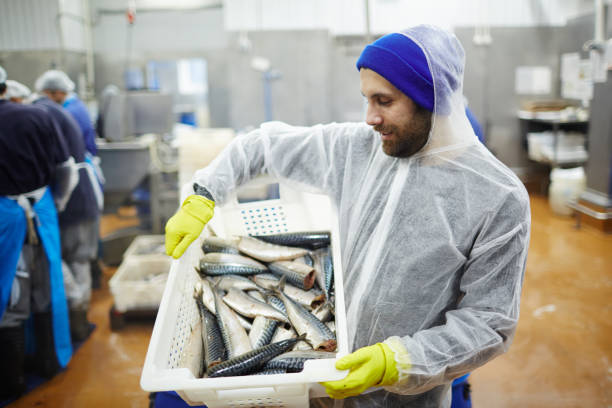The oceans, vast and teeming with life, have long been a source of sustenance and wonder for humanity. For generations, seafood has graced our tables, providing nourishment and delight. However, as our appetites for seafood have grown, so too have the challenges facing our oceans. Unsustainable fishing practices, overfishing, and environmental degradation threaten the delicate balance of marine ecosystems.
In recent years, a powerful wave of change has been sweeping through the seafood industry. Consumers are no longer content with simply enjoying the bounty of the sea; they are demanding change, driven by a growing awareness of the environmental impact of their choices. This awakening has led to a surge in the demand for sustainable seafood options.
This blog post embarks on a journey to explore the transformation of the seafood industry, driven by a profound shift in consumer preferences. We’ll delve into the rise of eco-friendly seafood, examining the reasons behind its popularity and the consequences of unsustainable practices. Moreover, we’ll venture into the exciting realm of investments within this burgeoning sector.
The Rise of Eco-Friendly Seafood
As we delve deeper into the world of sustainable seafood, it’s crucial to understand why there’s been such a remarkable rise in its popularity. The shift towards eco-friendly seafood is driven by a combination of factors, all pointing towards a more responsible and ethical approach to satisfying our seafood cravings.
Consumer Awareness and Values
One of the primary drivers behind the surge in demand for sustainable seafood is heightened consumer awareness. People are increasingly informed about the issues plaguing our oceans, thanks to documentaries, news reports, and environmental campaigns. They’ve witnessed the devastating consequences of overfishing, plastic pollution, and climate change on marine life.
With this awareness comes a shift in values. Consumers are now looking beyond taste and convenience when making seafood choices. They want their consumption to reflect their concern for the environment and the future of our oceans. Sustainable seafood aligns perfectly with these values.
Health and Nutrition
Beyond environmental concerns, consumers are also paying more attention to their health and nutrition. Seafood is often lauded for its nutritional benefits, rich in omega-3 fatty acids, protein, and essential minerals. As a result, people are seeking out seafood options that are not only good for the planet but also good for their well-being.
Sustainable seafood often comes from sources that prioritise the health of aquatic ecosystems. This means reduced exposure to harmful chemicals and contaminants, making it a healthier choice for consumers.
Government and Industry Initiatives
Governments and industry players are also playing a crucial role in promoting sustainable seafood. Many countries have implemented regulations and policies to curb overfishing and encourage sustainable fishing practices. Additionally, seafood industry associations and organisations are working to improve transparency and accountability in the supply chain.
Certifications like the Marine Stewardship Council (MSC) and Aquaculture Stewardship Council (ASC) have gained prominence, helping consumers easily identify eco-friendly seafood products. These initiatives provide consumers with confidence that their seafood choices are contributing to a healthier planet.
Culinary Innovation
The culinary world is embracing sustainable seafood as well. Chefs and restaurants, known for their influence on food trends, are featuring eco-friendly seafood on their menus. These tastemakers are demonstrating that sustainability and culinary excellence can go hand in hand, further encouraging consumers to explore and embrace sustainable options.
The Consequences of Unsustainable Practices
To appreciate the rise of eco-friendly seafood fully, it’s essential to acknowledge the stark consequences of unsustainable practices. Overfishing, for instance, has depleted fish stocks in numerous regions, leading to economic hardship for fishermen and disruptions in marine ecosystems. Bycatch, as previously mentioned, results in the accidental capture of non-target species, often with fatal consequences for these unintended victims.
Moreover, destructive fishing practices can harm sensitive habitats like coral reefs and seafloor ecosystems, impacting not only the marine life but also the overall health of our oceans.
In the wake of these issues, consumers are taking a stand. They are demanding a change in how seafood is sourced and produced. Sustainable seafood represents a vital step in the right direction, and it’s a trend that shows no sign of slowing down.
The Business Case for Sustainable Seafood
As we navigate the waters of investing in sustainable seafood, it’s essential to understand why this sector is not just a moral choice but also a smart business decision. There’s a compelling business case for embracing eco-friendly practices in the seafood industry, and it extends far beyond simply appeasing environmentally conscious consumers.
Meeting Consumer Demand
One of the most apparent reasons to invest in sustainable seafood is to meet the growing demand of conscious consumers. With more people actively seeking eco-friendly options, businesses that prioritise sustainability gain a competitive edge in the market. This demand is not a passing fad; it’s a fundamental shift in consumer behaviour that’s here to stay.
Enhanced Reputation and Brand Value
Sustainability isn’t just about doing the right thing; it’s also about building a strong brand. Companies that champion sustainable seafood practices often enjoy a boost in their reputation and brand value. They are seen as responsible stewards of the environment, which can lead to increased customer loyalty and trust.
Risk Mitigation
Investing in sustainable practices can also be a form of risk mitigation. Unsustainable fishing practices and environmental damage can lead to regulatory fines, lawsuits, and reputational damage. By adopting sustainable methods, businesses can reduce their exposure to these risks.
Access to Premium Markets
Many premium markets and retailers are increasingly demanding sustainable seafood products. By aligning with these standards, seafood businesses can access higher-end markets and command premium prices for their products. This can lead to improved profitability and sustainability in the long run.
Market Growth
The sustainable seafood market is on a growth trajectory. As more consumers demand eco-friendly options, the market for sustainable seafood is expanding. This growth potential presents significant opportunities for businesses to capture market share and increase their profits.
Operational Efficiency
Sustainable seafood practices often involve greater efficiency in resource utilisation. Reduced bycatch, responsible harvesting, and efficient supply chain management can result in cost savings for businesses. This improved operational efficiency can lead to higher profit margins.
Investment Opportunities

As the world shifts towards sustainability in the seafood industry, investors have a unique opportunity to both make a positive impact and achieve financial success. The sustainable seafood sector offers a range of investment opportunities, catering to various risk appetites and capital levels.
1. Publicly Traded Seafood Companies
Investing in publicly traded seafood companies that prioritise sustainability is a straightforward way to enter the market. These companies often have established track records and can provide investors with exposure to the growing demand for eco-friendly seafood. Research companies with strong sustainability practices, and consider their financial performance and growth potential.
2. Venture Capital and Private Equity
Venture capital and private equity investments in sustainable seafood startups and businesses have been on the rise. These investments support innovative solutions in seafood production, distribution, and technology. Look for investment opportunities in companies that are working on cutting-edge solutions for sustainable seafood farming, fishing, and distribution.
3. Sustainable Seafood Funds
Dedicated sustainable seafood funds and impact investment platforms are emerging to cater to investors looking for eco-friendly options. These funds curate portfolios of companies committed to sustainable seafood practices. Research the track record, investment strategies, and impact metrics of such funds to find one that aligns with your investment goals.
4. Aquaculture Investments
Aquaculture, or fish farming, is a significant component of the sustainable seafood industry. Investing in sustainable aquaculture ventures can be rewarding. Look for aquaculture operations that prioritise responsible practices, minimise environmental impact, and produce high-quality seafood products.
5. Supply Chain and Technology Solutions
Investing in companies that provide supply chain and technology solutions for sustainable seafood can be a strategic move. These companies play a crucial role in ensuring transparency, traceability, and compliance with sustainability standards throughout the seafood supply chain.
6. Impact Bonds
Impact bonds related to sustainable seafood allow investors to support specific projects or initiatives with defined social and environmental outcomes. These bonds may fund initiatives like marine conservation, sustainable fishing projects, or the development of eco-friendly fishing gear.
7. Collaborative Initiatives
Some investors choose to collaborate with organisations, NGOs, or government agencies focused on sustainable seafood initiatives. This approach can involve providing funding, expertise, or support for projects that align with environmental and social objectives.
Diversify Your Portfolio
As with any investment, diversification is key to managing risk. Consider spreading your investments across various sectors within the sustainable seafood industry to reduce exposure to market volatility and specific risks associated with individual companies or projects.
Research and Due Diligence
Before making any investments in sustainable seafood, conduct thorough research and due diligence. Understand the environmental and social impact of the companies or projects you are considering, as well as their financial performance and sustainability practices.
Stay Informed and Engaged
Investing in sustainable seafood isn’t just about putting money into a venture; it’s about actively participating in positive change. Stay informed about industry trends, regulations, and emerging opportunities. Engage with the companies and initiatives you invest in to ensure they uphold their commitment to sustainability.
Risks and Challenges
While the sustainable seafood sector offers promising investment opportunities, like any market, it comes with its share of risks and challenges. Investors should be aware of these factors and take steps to mitigate potential pitfalls. Let’s explore some of the key risks and challenges associated with investing in sustainable seafood.
1. Market Volatility
As with any investment, the sustainable seafood sector can experience market volatility. Factors like fluctuations in seafood prices, changes in consumer preferences, and global economic conditions can impact the financial performance of seafood companies. Diversifying your investment portfolio within the sector can help mitigate this risk.
2. Regulatory and Compliance Risks
The seafood industry is subject to various regulations aimed at ensuring sustainability and protecting marine ecosystems. Changes in regulations or non-compliance by seafood companies can lead to legal and financial risks. It’s essential to stay informed about evolving regulations and invest in companies that prioritise compliance.
3. Supply Chain Challenges
Seafood supply chains can be complex and vulnerable to disruptions. Issues such as overfishing, climate change, and geopolitical factors can affect the availability and quality of seafood products. Investors should assess the resilience of a company’s supply chain and its ability to adapt to changing conditions.
4. Environmental and Social Risks
Investors interested in sustainable seafood often prioritise environmental and social responsibility. Companies that fail to meet sustainability standards or engage in harmful practices can face reputational damage and consumer backlash. Due diligence is crucial to ensure that investments align with ethical and environmental values.
5. Market Competition
As awareness of sustainable seafood grows, more companies are entering the market. Increased competition can put pressure on profit margins and market share. Investors should carefully assess a company’s competitive position and its ability to differentiate itself in the market.
6. Certification and Verification
Certifications like MSC and ASC are essential for verifying seafood sustainability. However, the credibility and rigour of these certifications can vary. Investors should verify that the companies they invest in have reputable certifications and adhere to robust sustainability practices.
Mitigating Risks
To mitigate the risks associated with investing in sustainable seafood, consider the following strategies:
– Diversification:
Spread your investments across different sectors within the sustainable seafood industry to reduce exposure to specific risks.
– Due Diligence:
Conduct thorough research and due diligence before investing in any company or project. Assess their sustainability practices, financial performance, and compliance with regulations.
– **Engagement**:
Actively engage with the companies or initiatives you invest in to monitor their commitment to sustainability and ethical practices.
– **Stay Informed**:
Stay updated on industry trends, regulations, and market conditions. This knowledge will help you make informed investment decisions.
– **Collaboration**:
Consider collaborating with impact-focused organisations or funds that specialise in sustainable seafood investments. They can provide expertise and guidance.
While there are risks involved, the sustainable seafood sector offers significant potential for both financial returns and positive environmental and social impact. With careful consideration and proactive risk management, investors can contribute to a more sustainable and responsible seafood industry.
Impact Investing in Sustainable Seafood
Investing in sustainable seafood isn’t just about generating financial returns; it’s also a way to make a positive impact on the environment and society. This concept is at the heart of impact investing, which seeks to generate both financial and non-financial returns by supporting businesses and initiatives aligned with specific social and environmental goals.
What is Impact Investing?
Impact investing is a growing trend that involves intentionally allocating capital to investments that have a positive impact on society or the environment. It’s a departure from traditional investing, which primarily focuses on financial returns. Impact investors prioritise outcomes such as sustainability, social responsibility, and ethical practices.
How Does Impact Investing Apply to Sustainable Seafood?
In the context of sustainable seafood, impact investing means directing your capital towards businesses and projects that are committed to environmentally responsible and socially beneficial practices within the seafood industry. Impact investors seek to address specific challenges like overfishing, habitat destruction, and social equity concerns while earning a financial return on their investments.
Aligning Values with Financial Returns
Impact investors in sustainable seafood align their values with their financial goals. They actively seek out opportunities to support companies and initiatives that prioritise sustainability, conservation, and ethical labour practices. By doing so, they contribute to positive change in the industry while potentially earning competitive returns on their investments.
Investment Opportunities in Impactful Sustainable Seafood
Impact investing opportunities within sustainable seafood are diverse and can include:
1.Supporting Sustainable Fishing Practices:
Investing in companies that promote responsible and sustainable fishing methods, reducing bycatch and protecting marine ecosystems.
2.Aquaculture Innovations:
Backing aquaculture projects that focus on minimising environmental impact, reducing antibiotics use, and improving fish welfare.
3.Traceability and Transparency Solutions:
Investing in technology companies that provide tools for tracking seafood from source to plate, ensuring transparency and preventing illegal, unreported, and unregulated (IUU) fishing.
4.Marine Conservation Initiatives:
Supporting nonprofit organisations or projects dedicated to marine conservation, habitat restoration, and sustainable fisheries management.
5.Ethical Labor Practices:
Investing in seafood businesses that prioritise fair labour practices, ensuring that workers are treated equitably and paid fairly.
The Potential for Dual Returns
One of the key attractions of impact investing in sustainable seafood is the potential for dual returns—financial and non-financial. While investors aim to achieve competitive financial returns, they also contribute to positive environmental and social outcomes. This dual focus allows investors to align their portfolios with their values and make a meaningful difference.
Impact Investing Platforms and Funds
For those interested in impact investing but unsure where to start, impact-focused investment platforms and funds can provide guidance and opportunities. These platforms curate portfolios of impact investments, making it easier for investors to channel their capital into projects and businesses that align with their values.
Tools for Assessing Sustainability
Investors looking to make informed decisions in the sustainable seafood sector have a range of tools and certifications at their disposal to assess the environmental and social impact of their investments. These tools help evaluate whether seafood businesses and initiatives meet sustainability standards and align with responsible practices.
1. Marine Stewardship Council (MSC)
The Marine Stewardship Council is a widely recognized certification program for wild-caught seafood. It sets rigorous standards for sustainable fishing practices, ensuring that fish stocks are healthy, bycatch is minimised, and ecosystems are protected. MSC-certified products carry the blue label, providing consumers and investors with a clear indicator of sustainability.
2. Aquaculture Stewardship Council (ASC)
The Aquaculture Stewardship Council focuses on sustainable aquaculture practices. ASC certification ensures that fish farms meet environmental and social criteria, including responsible water use, minimal chemical use, and fair labour practices. Investors can look for ASC certification to support sustainable aquaculture ventures.
3. Seafood Watch
Seafood Watch, run by the Monterey Bay Aquarium, offers a comprehensive sustainability guide and app. It provides up-to-date information on the environmental impact of various seafood products. Investors can use Seafood Watch to research the sustainability of specific species and businesses.
4. Global Sustainable Seafood Initiative (GSSI)
GSSI is an industry-driven initiative that benchmark standards for seafood certification programs. It helps ensure that various seafood certification schemes meet globally recognized sustainability criteria. Investors can use GSSI to evaluate the credibility and consistency of certification programs.
5. Traceability Technology
Investors can look for seafood companies that use traceability technology to monitor their supply chains. Blockchain and other traceability solutions offer transparency by tracking the journey of seafood products from the source to consumers. These technologies can help prevent illegal fishing and ensure compliance with sustainability standards.
6. Sustainability Reports
Many seafood companies now publish sustainability reports detailing their efforts to meet sustainability goals. These reports provide insight into a company’s commitment to environmental and social responsibility. Investors should review these reports as part of their due diligence.
7. Industry Associations
Investors can also engage with industry associations dedicated to sustainable seafood, such as the Sustainable Fisheries Partnership. These organisations provide resources, guidance, and insights into sustainable practices and industry trends.
Using Tools for Informed Investment Decisions
Investors interested in sustainable seafood should incorporate these tools into their investment research process. By assessing the sustainability practices of companies and projects, investors can align their portfolios with their values and support initiatives that contribute to a more responsible seafood industry.
The Importance of Transparency
Transparency is a critical component of sustainable seafood. Investors should prioritise businesses and initiatives that are transparent about their sustainability practices, certifications, and the impact they make on marine ecosystems and communities. Transparent companies are more likely to adhere to ethical and sustainable principles.
Conclusion
In this journey through the world of sustainable seafood investment, we’ve explored the rising demand for eco-friendly options, the financial benefits, and the tools for making informed choices. By investing in sustainable seafood, you can profit while preserving our oceans and communities. It’s more than a trend; it’s a movement driven by informed consumers.
Align your values with investments through impact investing in sustainable seafood. Direct your capital toward businesses prioritising sustainability for a responsible and ethical seafood
Leverage resources like MSC, ASC, Seafood Watch, traceability tech, and industry associations to evaluate sustainability practices.
Transparent companies uphold ethical and sustainable values, making them attractive investments.
Your investments contribute to preserving marine ecosystems, supporting responsible fishing, and ensuring equitable treatment for seafood industry workers.
As an individual investor, part of an impact-focused fund, or conscious consumer, your choices drive positive change.












